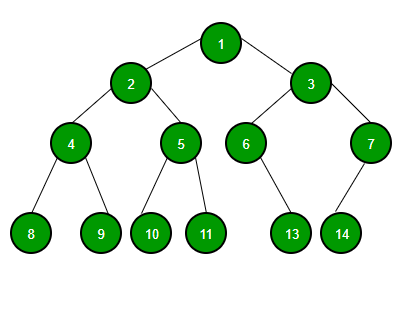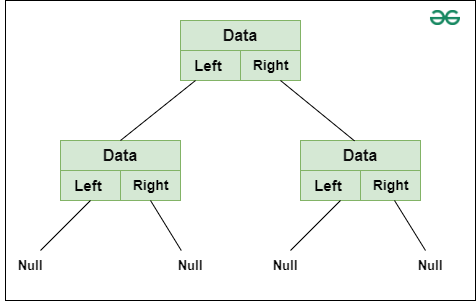Binary Tree in C
A binary tree is a non-linear hierarchical data structure in which each node has at most two children known as the left child and the right child. It can be visualized as a hierarchical structure where the topmost node is called the root node and the nodes at the bottom are called leaf nodes or leaves.
In this article, we will learn the basics of binary trees, types of binary trees, basic operations that can be performed on binary trees as well as applications, advantages, and disadvantages of binary trees in C.
Representation of Binary Tree

Binary Tree Representation
Each node of a binary tree has the following 3 parts:

Binary Tree- Node Representation
To create a binary tree, we have to first create a node having a data, pointer to left child and pointer to right child using the below structure format:
struct node
int data;
struct node *left;
struct node *right;
>;
Basic Operations on Binary Tree in C
The following are the basics operations that can performed on a binary tree:
- Insertion
- Deletion
- Search
- Traversing (Pre-order, Post-order and In-order)
Here, we will learn about three basic operations that can be performed on a binary: insertion, deletion, and searching.
This function is used to insert values in a binary tree.
This function is used to delete the specified node from a binary tree
This function is used to search a given key in a binary tree
1. Insertion in Binary Tree
In a binary tree a new node can be inserted anywhere as a right child or left child of a node. To insert a node in a binary tree, follow the below approach:
Approach:
- Start iterating using level order traversal in a binary tree.
- If a node whose left child is missing is found then insert the given new node as the left child of that node.
- Else if a node whose right child is missing is found then insert the given node as the right child of that node.
- Else a node whose both right child and left child are missing is found then insert the new node as the left or right child (any position) of that node.
2. Deletion in Binary Tree
In a binary tree we can delete a node from anywhere and then again rearrange it to maintain the property of binary tree and the leaf nodes can be deleted without performing any replacement and shifting of nodes. To delete a node from a binary tree, follow the below approach:
Approach:
- Start traversing from the root node of the tree.
- Find the node that you want to delete and the node at the deepest right.
- Replace the target node (node to be deleted ) with the deepest rightmost node.
- Finally, delete the deepest rightmost node (as it contains the node to be deleted now).
3. Searching in Binary Tree
In a binary tree we can search a node by traversing and comparing each node with target node (node to be searched). To search for a given node in a binary tree follow the below approach:
Approach:
- Start traversing from the root node of the tree.
- Compare the target node (node to be searched) with each node’s value.
- If the current node’s value is equal to target node, then target node is found.
- else if, the current node’s value is not equal to target node, again start searching the left and right child by traversing.
- else, you reach the end of the tree and do no find any node’s value equal to target value, then the target node is not present in the tree.
C Program to Implement Binary Tree
The below program demonstrates all the basic operations on a binary search tree: creation, searching, traversal, insertion and deletion in C.
Output
Inorder traversal of the given Binary Search Tree is: 50 30 60 20 70 40 80 After deletion of 20: 50 30 60 80 70 40 After insertion of 25: 50 30 60 80 70 40 25 Node 25 found in the BST.
Time Complexity: O(N), here N is the number of nodes in a binary tree.
Auxilliary Space: O(N)
Types of Binary Trees in C
Binary trees can be of many types depending on the parameter we took for the classification of the trees. The following are the types of binary trees:
According to Number of Children
- Full Binary Tree : A binary tree in which every node other than the leaves has two children.
- Degenerate Binary Tree : A tree where each parent node has only one child.
- Skewed Binary Trees : A binary tree in which all the nodes are skewed to the left or right.
According to Completion of Levels
- Complete Binary Tree : A binary tree in which all levels are completely filled except possibly the last level, and the last level has all keys as left as possible.
- Perfect Binary Tree : A binary tree in which all the internal nodes have two children and all leaves are at the same level.
- Balanced Binary Tree : A binary tree in which the height of the left and right subtrees of any node differ by not more than one.
According to Node Values
- Binary Search Tree (BST) : A binary tree in which all the left descendants of a node are less than the node and all the right descendants are greater than the node.
- AVL Tree : A self-balancing binary search tree where the difference in heights between left and right subtrees is at most one.
- Red-Black Tree : A binary search tree with an extra bit of storage per node: its color, which can be either red or black. It ensures the tree remains balanced.
- B Tree : A self-balancing search tree in which nodes can have multiple children and is optimized for systems that read and write large blocks of data.
- B+ Tree : An extension of the B tree which maintains the data in a sorted order and allows sequential access.
- Segment Tree : A binary tree used for storing the intervals or segments. It allows querying which of the stored segments contain a given point.
- Fenwick Tree (Binary Indexed Tree) : A data structure that provides efficient methods for calculation and manipulation of the prefix sums of a table of values.
Applications of Binary Trees
Binary tree are the versatile data structure widely used in the various applications due to the hierarchical nature and efficient performance in the certain operations. Following are some applications of the binary tree:
- Full Binary Tree: It is used in the binary heap implementations and it is optimal merge patterns.
- Complete Binary Tree: It is used in the binary heaps which are useful in the priority queues and it is used in the efficient storage management such as heap sort.
- Perfect Binary Tree: It is used in the complete binary tree implementation for the efficiency and it is perfect for the implementing full binary trees in the array representations.
- Balanced Binary Tree: It is used in the AVL and Red-Black trees for the efficient searching operation, insertion operation and deletion operation.
- Binary Search Tree (BST): It is used in the database indexing and also it is used in the dictionary and phonebook applications. It is also efficient for the search operation, insert operation and delete operation when it was balanced.
- AVL Tree: It is used in the situations where the search time needs to be minimized. It is database applications where the frequent insertions and deletions are expected.
- Red-Black Tree: It is used in C++ STL map and multimap implementations.
- Segment Tree: It is used in the computational geometry for the problems such as finding intersections, range, queries, etc.,
- Fenwick Tree (Binary Indexed Tree): It is used in the scenarios requiring the dynamic cumulative frequency tables. It is efficient for the frequency queries and updates.
Frequently Asked Questions on C Binary Tree
What is a binary tree?
A binary tree is a special type of data structure where each node has at most two children called as left and right child nodes.
What are the applications of Binary Tree?
- Binary Search Trees(BST)
- Heaps
- Expression Trees
- Huffman Trees
- Binary Trees
What is the time complexities of basic operations on a Binary Tree?
- The time complexity of insertion operation is O(h).
- The time complexity of search operation is O(h).
- The time complexity of deletion operation is O(h).
- The time complexity of traversal operation is O(n).
What are the different types of Binary Tree?
- According to Number of Children
- Full Binary Tree
- Degenerate Binary Tree
- Skewed Binary Trees
- Complete Binary Tree
- Perfect Binary Tree
- Balanced Binary Tree
- Binary Search Tree
- AVL Tree
- Red Black Tree
- B Tree
- B+ Tree
- Segment Tree
What is a balanced binary tree?
A balanced binary tree is also called as height-balanced binary tree, it is a type of binary tree in which the height of the left and right subtree of any node differs by not more than one.
What is Complete Binary Tree?
A complete binary tree is the type of the binary tree in which all levels are completely filled except the possibility the last level, and last level have all keys as left as possible. This type of the binary tree is used in implementation of the binary heaps.
What is AVL Tree?
An AVL tree is the self-balanced binary search tree where difference in the heights between left and right subtree of the node is atmost one. AVL trees are provide the faster search times compared to the unbalanced binary search trees by the maintaining the balanced structure.



